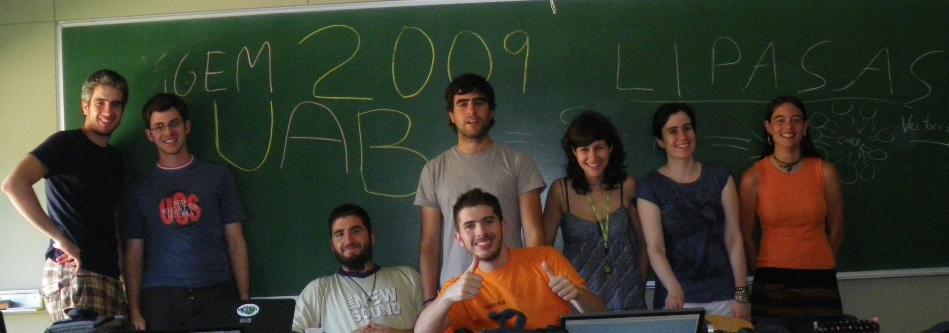Team:UAB-Barcelona
From 2009.igem.org
(→OUR TEAM PICTURE) |
(→BACKGROUND) |
||
| (84 intermediate revisions not shown) | |||
| Line 1: | Line 1: | ||
| - | + | {{Template:UAB-Barcelona2}} | |
| - | + | ||
== '''BACKGROUND''' == | == '''BACKGROUND''' == | ||
| - | {| | + | {|class="wikitable" border="0" cellpadding="10" cellspacing="1" style="padding: 0; background-color:black; border: 1px solid black; text-align:justify; margin:5px -5px 5px -5px" |
| - | | | + | !width="30%"; valign="top" style="background:#ECC850; color:black"| |
| - | + | ||
| + | The Universitat Autònoma of Barcelona (UAB) is one of the most prestigious universities of Spain, pioneer in investigation and innovation. Our project will be developed in the Chemical Engineering School laboratories, under supervision of the professors Juan Antonio Baeza Labat, Joan Albiol Sala and Pau Ferrer Alegre. The team will be formed by eight students: three biotechnologists and two chemical engineers from the UAB, and three Pharmacy students, two from the University of Granada and one from the University of Santiago. | ||
| + | |||
| + | Our project will consist of developing an ''Escherichia coli'' biosensor that could detect trihalomethanes in water. The idea is to use a protein called GFP, which expression can be induced by these pollutants. This protein produces, after being excited, green fluorescence, which constitutes the signal that reveals those substances. Using ''E. coli'' brings some advantages: it’s easy to manipulate and its genome and cultivation are well-known and deeply studied. | ||
| + | |||
| + | But after long days of testing and trying we realized it was impossible to obtain interesting results and send useful new parts. | ||
| + | |||
| + | So in the middle of September we headed to a new project. In a month we would try to design and build a nitrite, nitrate and phosphate biosensor. | ||
| + | |||
| + | And at the same time, we wanted to add a new regulating pathway based on Nitrosomonas Europaea nirK (a nitrite reductase) promoter and nsr protein. With this system, people will be able to begin the synthesis of a protein with the addition of NO2- to the medium. | ||
| - | |||
| - | |||
|- | |- | ||
|} | |} | ||
| - | + | == '''WHO WE ARE''' == | |
| + | [[Image:totsigem.jpg|965px|right]] | ||
| - | + | == '''ACKNOWLEDGEMENTS''' == | |
| - | + | ||
| - | + | ||
| - | + | ||
| - | + | ||
| - | + | ||
| - | + | ||
| - | + | ||
| - | = | + | <html> |
| - | + | <a href=http://www.uab.es/english/><img src=https://static.igem.org/mediawiki/2009/6/64/Uab_logo2.png></a> | |
| - | == | + | <a href=http://eq3.uab.es/><img src=https://static.igem.org/mediawiki/2009/3/35/LogoDEQ.jpg></a> |
| - | + | ||
| - | + | <a href="http://www2.clustrmaps.com/counter/maps.php?url=https://2009.igem.org/Team:UAB-Barcelona" id="clustrMapsLink"><img src="http://www2.clustrmaps.com/counter/index2.php?url=https://2009.igem.org/Team:UAB-Barcelona" style="border:0px;" alt="Locations of visitors to this page" title="Locations of visitors to this page" id="clustrMapsImg" onerror="this.onerror=null; this.src='http://clustrmaps.com/images/clustrmaps-back-soon.jpg'; document.getElementById('clustrMapsLink').href='http://clustrmaps.com';" /> | |
| + | </a> | ||
| + | </html> | ||
| + | |||
| + | == '''SPONSORS''' == | ||
| + | {|class="wikitable" border="0" cellpadding="10" cellspacing="1" style="padding: 0; background-color:black; border: 1px solid black; text-align:center; margin:5px -5px 5px -5px" | ||
| + | !width="30%" align="left" valign="top" style="background:#ECC850; color:black"| | ||
| + | '''Do you want to contribute to the success of this experience? | ||
| + | |||
| + | We are currently looking for sponsorships, join us. Any help is welcome. | ||
| + | |||
| + | Please contact with the coordinator of the UAB-Barcelona Team: JuanAntonio.Baeza@uab.cat''' | ||
| + | |- | ||
| + | |} | ||
Latest revision as of 11:27, 20 October 2009
Contents |
BACKGROUND
|
The Universitat Autònoma of Barcelona (UAB) is one of the most prestigious universities of Spain, pioneer in investigation and innovation. Our project will be developed in the Chemical Engineering School laboratories, under supervision of the professors Juan Antonio Baeza Labat, Joan Albiol Sala and Pau Ferrer Alegre. The team will be formed by eight students: three biotechnologists and two chemical engineers from the UAB, and three Pharmacy students, two from the University of Granada and one from the University of Santiago. Our project will consist of developing an Escherichia coli biosensor that could detect trihalomethanes in water. The idea is to use a protein called GFP, which expression can be induced by these pollutants. This protein produces, after being excited, green fluorescence, which constitutes the signal that reveals those substances. Using E. coli brings some advantages: it’s easy to manipulate and its genome and cultivation are well-known and deeply studied. But after long days of testing and trying we realized it was impossible to obtain interesting results and send useful new parts. So in the middle of September we headed to a new project. In a month we would try to design and build a nitrite, nitrate and phosphate biosensor. And at the same time, we wanted to add a new regulating pathway based on Nitrosomonas Europaea nirK (a nitrite reductase) promoter and nsr protein. With this system, people will be able to begin the synthesis of a protein with the addition of NO2- to the medium. |
|---|
WHO WE ARE
ACKNOWLEDGEMENTS
SPONSORS
|
Do you want to contribute to the success of this experience? We are currently looking for sponsorships, join us. Any help is welcome. Please contact with the coordinator of the UAB-Barcelona Team: JuanAntonio.Baeza@uab.cat |
|---|
 "
"



